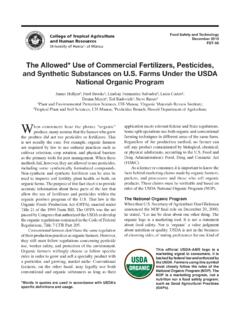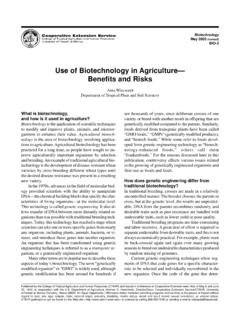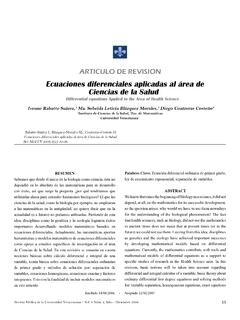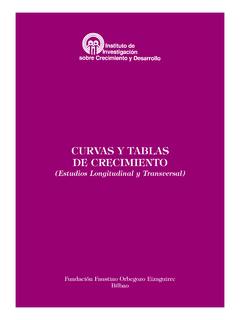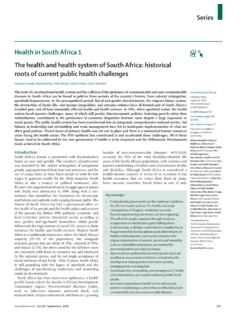Transcription of Essential Nutrients for Plant Growth: Nutrient Functions ...
1 31 Plant Nutrient Management in Hawaii s SoilsPlants, like all other living things, need food for theirgrowth and development. Plants require 16 essen-tial elements. Carbon, hydrogen, and oxygen are de-rived from the atmosphere and soil water. The remain-ing 13 Essential elements (nitrogen, phosphorus, po-tassium, calcium, magnesium, sulfur, iron, zinc, man-ganese, copper, boron, molybdenum, and chlorine) aresupplied either from soil minerals and soil organicmatter or by organic or inorganic plants to utilize these Nutrients efficiently, light,heat, and water must be adequately supplied. Culturalpractices and control of diseases and insects also playimportant roles in crop type of Plant is unique and has an optimumnutrient range as well as a minimum requirement this minimum level, plants start to show nutri-ent deficiency symptoms.
2 Excessive Nutrient uptake canalso cause poor growth because of toxicity. Therefore,the proper amount of application and the placement ofnutrients is and Plant tissue tests have been developed toassess the Nutrient content of both the soil and analyzing this information, Plant scientists can de-termine the Nutrient need of a given Plant in a givensoil. In addition to the levels of Plant -available nutri-ents in soils, the soil pH plays an important role in nu-trient availability and elemental toxicity (see p. 46).This chapter describes the Essential Nutrients , thechemical forms in which they are available to plants,their function in plants, symptoms of their deficien-cies, and recommended Nutrient levels in Plant tissuesof selected : N; available to plants as nitrate (NO3 ) , andammonium (NH4+) Functions N is biologically combined with C, H, O, and S tocreate amino acids, which are the building blocks ofproteins.
3 Amino acids are used in forming proto-plasm, the site for cell division and thus for plantgrowth and development. Since all Plant enzymes are made of proteins, N isneeded for all of the enzymatic reactions in a Plant . N is a major part of the chlorophyll molecule and istherefore necessary for photosynthesis. N is a necessary component of several vitamins. N improves the quality and quantity of dry matter inleafy vegetables and protein in grain symptoms (p. 33) Stunted growth may occur because of reduction incell division. Pale green to light yellow color (chlorosis) appear-ing first on older leaves, usually starting at the on the severity of deficiency, the chloro-sis could result in the death and/or dropping of theolder leaves.
4 This is caused by the translocation ofChapter 3 Essential Nutrients for Plant Growth: Nutrient Functions and Deficiency SymptomsR. UchidaFrom: Plant Nutrient Management in Hawaii s Soils, Approaches for Tropical and Subtropical AgricultureJ. A. Silva and R. Uchida, eds. College of Tropical Agriculture and Human Resources, University of Hawaii at Manoa, 200032 Essential NutrientsCollege of Tropical Agriculture and Human Resources, University of Hawaii at ManoaN from the older to the younger tissues. Reduced N lowers the protein content of seeds andvegetative parts. In severe cases, flowering is greatlyreduced. N deficiency causes early maturity in some crops,which results in a significant reduction in yield : P; available to plants as orthophosphate ions(HPO42 , H2PO4 ).
5 Nutrient Functions In photosynthesis and respiration, P plays a majorrole in energy storage and transfer as ADP and ATP(adenosine di- and triphosphate) and DPN and TPN(di- and triphosphopyridine nucleotide). P is part of the RNA and DNA structures, which arethe major components of genetic information. Seeds have the highest concentration of P in a ma-ture Plant , and P is required in large quantities inyoung cells, such as shoots and root tips, where me-tabolism is high and cell division is rapid. P aids in root development, flower initiation, and seedand fruit development. P has been shown to reduce disease incidence in someplants and has been found to improve the quality ofcertain symptoms (p.)
6 34) Because P is needed in large quantities during theearly stages of cell division, the initial overall symp-tom is slow, weak, and stunted growth. P is relatively mobile in plants and can be transferredto sites of new growth, causing symptoms of dark toblue-green coloration to appear on older leaves ofsome plants. Under severe deficiency, purpling ofleaves and stems may appear. Lack of P can cause delayed maturity and poor seedand fruit : K; available to plants as the ion K+ Nutrient Functions Unlike N and P, K does not form any vital organiccompounds in the Plant . However, the presence ofK is vital for Plant growth because K is known to bean enzyme activator that promotes metabolism.
7 K assists in regulating the Plant s use of water bycontrolling the opening and closing of leaf stomates,where water is released to cool the Plant . In photosynthesis, K has the role of maintaining thebalance of electrical charges at the site of ATP pro-duction. K promotes the translocation of photosythates (sug-ars) for Plant growth or storage in fruits or roots. Through its role assisting ATP production, K is in-volved in protein synthesis. K has been shown to improve disease resistance inplants, improve the size of grains and seeds, and im-prove the quality of fruits and symptoms (p. 35) The most common symptom is chlorosis along theedges of leaves (leaf margin scorching).
8 This occursfirst in older leaves, because K is very mobile in theplant. Because K is needed in photosynthesis and the syn-thesis of proteins, plants lacking K will have slowand stunted growth. In some crops, stems are weak and lodging is com-mon if K is deficient. The size of seeds and fruits and the quantity of theirproduction is reduced. Color Section Symptoms of Plant nutrientdeficiencies and toxicitiesPhoto creditsAbbreviations given for sources of the photographs areas follows:ASHS: From Avocado Production in California, a slideset produced by Eugene Memmler and formerly distrib-uted by the American Society for Horticultural : The American Phytopathological Society; fromNutrient Deficiencies and Toxicities in Crop Plants, Bennett (editor), 1993; used with : Potash & Phosphate Institute; used with : USDA-ARS George E.
9 Brown, Jr. Salinity Lab-oratory, Riverside, CA; eucalyptus photos courtesy ofCatherine M.. continued on p. 4933 Plant Nutrient Management in Hawaii s SoilsNNitrogen deficient cucumber fruit ismisshapen and deficient potato Plant (left) is chlorotic; Plant at rightis deficient soybean; lower leaves turn uniformly palegreen, then symptoms Stunted growth may occur because of reduc-tion in cell division. Pale green to light yellow color (chlorosis) ap-pearing first on older leaves, usually starting atthe tips. Depending on the severity of deficiency,the chlorosis could result in the death and/ordropping of the older leaves. This is caused bythe translocation of N from the older to theyounger tissues.
10 Reduced N lowers the protein content of seedsand vegetative parts. In severe cases, flower-ing is greatly reduced. N deficiency causes early maturity in somecrops, which results in a significant reduction inyield and deficient corn; yellowing proceeds down the midribof older nitrogen deficiency in NutrientsCollege of Tropical Agriculture and Human Resources, University of Hawaii at ManoaPPhosphorus deficient sugarbeet plants are stunted, with dark green deficient corn; lower leaves become deficient tomato leaves havepurple interveinal tissue on their deficient potato plants are stunted, with dark green N. TamimiPPID eficiency symptoms Because P is needed in large quantities duringthe early stages of cell division, the initial over-all symptom is slow, weak, and stunted growth.





